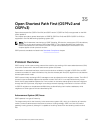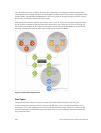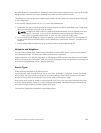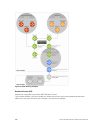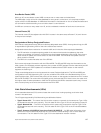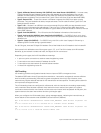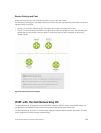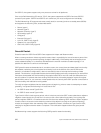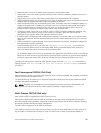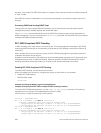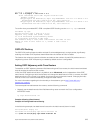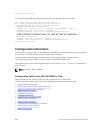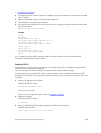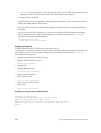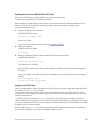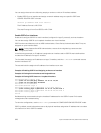
• Restarting role in which an enabled router performs its own graceful restart.
• Helper role in which the router's graceful restart function is to help a restarting neighbor router in its
graceful restarts.
• Helper-reject role in which OSPF does not participate in the graceful restart of a neighbor.
• OSPFv2 supports helper-only and restarting-only roles. By default, both helper and restarting roles are
enabled. OSPFv2 supports the helper-reject role globally on a router.
• OSPFv3 supports helper-only and restarting-only roles. The helper-only role is enabled by default. To
enable the restarting role in addition to the helper-only role, configure a grace period. Reconfigure
OSPFv3 graceful restart to a restarting-only role when you enable the helper-reject role on an
interface. OSPFv3 supports the helper-reject role on a per-interface basis.
• Configuring helper-reject role on an OSPFv2 router or OSPFv3 interface enables the restarting-only
role globally on the router or locally on the interface. In a helper-reject role, OSPF does not
participate in the graceful restart of an adjacent OSPFv2/v3 router.
• If multiple OSPF interfaces provide communication between two routers, after you configure helper-
reject on one interface, all other interfaces between the two routers behave as if they are in the help-
reject role.
• OSPFv2 and OSPFv3 support planned-only and/or unplanned-only restarts. The default is support for
both planned and unplanned restarts.
A planned restart occurs when you enter the redundancy force-failover rpm command to
force the primary RPM to switch to the backup RPM. During a planned restart, OSPF sends out a
Grace LSA before the system switches over to the backup RPM.
An unplanned restart occurs when an unplanned event causes the active RPM to switch to the backup
RPM, such as when an active process crashes, the active RPM is removed, or a power failure happens.
During an unplanned restart, OSPF sends out a Grace LSA when the backup RPM comes online.
To display the configuration values for OSPF graceful restart, enter the show run ospf command for
OSPFv2 and the
show run ospf and show ipv6 ospf database database-summary commands
for OSPFv3.
Fast Convergence (OSPFv2, IPv4 Only)
Fast convergence allows you to define the speeds at which LSAs are originated and accepted, and reduce
OSPFv2 end-to-end convergence time.
The Dell Networking OS allows you to accept and originate LSAa as soon as they are available to speed
up route information propagation.
NOTE: The faster the convergence, the more frequent the route calculations and updates. This
impacts CPU utilization and may impact adjacency stability in larger topologies.
Multi-Process OSPFv2 (IPv4 only)
Multi-process OSPF is supported on OSPFv2 with IPv4 only.
Multi-process OSPF allows multiple OSPFv2 processes on a single router. Multiple OSPFv2 processes
allow for isolating routing domains, supporting multiple route policies and priorities in different domains,
and creating smaller domains for easier management.
The MXL Switch supports up to 16 OSPFv2 processes.
Each OSPFv2 process has a unique process ID and must have an associated router ID. There must be an
equal number of interfaces and must be in Layer-3 mode for the number of processes created. For
Open Shortest Path First (OSPFv2 and OSPFv3)
621



